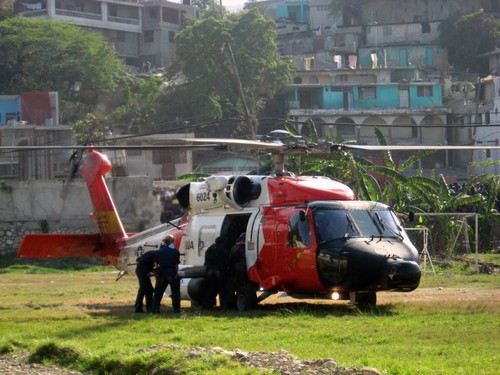 A massive earthquake struck Haiti just before 5 p.m. on Tuesday, January 12, about 10 miles southwest of Port-au-Prince, the country’s capital. The quake was the worst in the region in more than 200 years. The first responder was the US Coast Guard Cutter Forward, with an MH-65 Dolphin helicopter on board.
A massive earthquake struck Haiti just before 5 p.m. on Tuesday, January 12, about 10 miles southwest of Port-au-Prince, the country’s capital. The quake was the worst in the region in more than 200 years. The first responder was the US Coast Guard Cutter Forward, with an MH-65 Dolphin helicopter on board.
The Forward arrived off Port au Prince at 8 am on January 13. They immediately set up to provide air traffic control due to the damaged and inoperable control tower at Toussiant Louverture International Airport. A damage assessment of the port of Cap Haitian, the port through which the majority of relief supplies would pass through, was made. Significant damage and destruction of its infrastructure including the port’s container crane and other cargo cranes was noted. The port was determined to be useable but unable to initially support a large relief effort. The MH-65 reconnoitered the roadways leaving the port and verified that relief efforts delivered to Cap Haitian could be trucked to Port au Prince.
The Coast Guard Cutter Mohawk arrived in the coastal waters of Haiti in the afternoon of the 13th There were also three Coast Guard MH-65 helicopters and three H-60 helicopters operating. The aircrew of a Coast Guard H-60 Jayhawk helicopter medically evacuated four, critically injured U.S. citizens from the U.S. Embassy on the morning of the 13th and a second medevac of five people was conducted that afternoon. The injured were transported to the U.S. Naval Hospital in Guantanamo Bay, Cuba. Two Coast Guard C-130s arrived that evening with the ability to evacuate up to 140 personnel to Santo Domingo, Dominican Republic. Two other Coast Guard C-130s from Air Station Elizabeth City, N.C., are being prepositioned to Air Station Miami to support the relief efforts including the airlift to Haiti of two Urban Search and Rescue Teams which is being coordinated through the Southern Command. The Cutters Tahoma and Valiant arrived the next day. The Tahoma was loaded with relief supplies for earthquake survivors. The Cutters Hamilton and Oak arrived on Friday the 15th each carrying relief supplies. The Cutter Oak is a 225 foot buoy tender and was instrumental in opening the port or inbound cargo vessels.
Hillary Clinton, Secretary of State said: “Our Coast Guard has been unbelievable. They got there first, as you might guess.” Admiral Thad Allen, the U.S. Coast Guard Commandant, expressed appreciation for the secretary’s remarks and went on to say: “One of the things that is the hallmark of Coast Guard operations is the fact that our units are dispersed around the United States and can flow rather quickly. Ultimately we need the back-up of the larger DOD forces, but in this case we were able to be very responsive.”
- As of 6 p.m. Sunday, the fifth day since the earthquake the Coast Guard:
- Had evacuated 662 American citizens from Haiti.
- Transported 696 Urban Search and Rescue team members into Haiti.
- Coast Guard aircraft conducted 240 MEDEVACS.
- Transported a Department of Health and Human Services Disaster Medical Assistance Team and three surgeons.
- Provided transportation for personnel from FEMA, Health and Human Services, and the United Nations in support of relief efforts on the ground.
By the end of the fifth day DOD assets were moving in. The 82nd Airborne was assigned for security: A military team reopened the airport so it could handle large, heavy planes; and work was begun on upgrading port infrastructure.

World leaders pledged hundreds of millions of dollars and thousands of troops but delivering on these promises was a logistical nightmare. In the days after the quake, aid was arriving only in a trickle to those in need. Power was out and telecommunications rarely functioned. Most medical facilities had been severely damaged. Supplies of food and fresh water were dwindling. Ships could not bring their cargos of supplies into Haiti’s damaged port; the airport was functioning with severe limits; roads were blocked not only by debris but also by people with no safe shelter to retreat to. For weeks relief came in the form of food giveaways with biscuits and bottles of canola oil or biscuits thrown the backs of trucks to masses of people jockeying for position.
Unfortunately, although the initial efforts were outstanding the follow up has not been. A few days before the anniversary of the earthquake, Oxfam International, an international confederation of 14 organizations working with over 3,000 partners in around 100 countries, published a report on the status of the recovery. According to the report, relief and recovery are at a standstill due to inaction from the government and indecision on the part of the donor countries. The report states, “One year on, only five percent of the rubble has been cleared and only 15 percent of the required basic and temporary houses have been built. House building on a large scale cannot be started before the enormous amount of rubble is cleared. The government and donors must prioritize this most basic step toward helping people return home”. Robert Fox, executive director with Oxfam Canada, said “The dysfunction has been aided unabated by the way the international community has organized itself, where pledges have been made and they haven’t followed through”.
